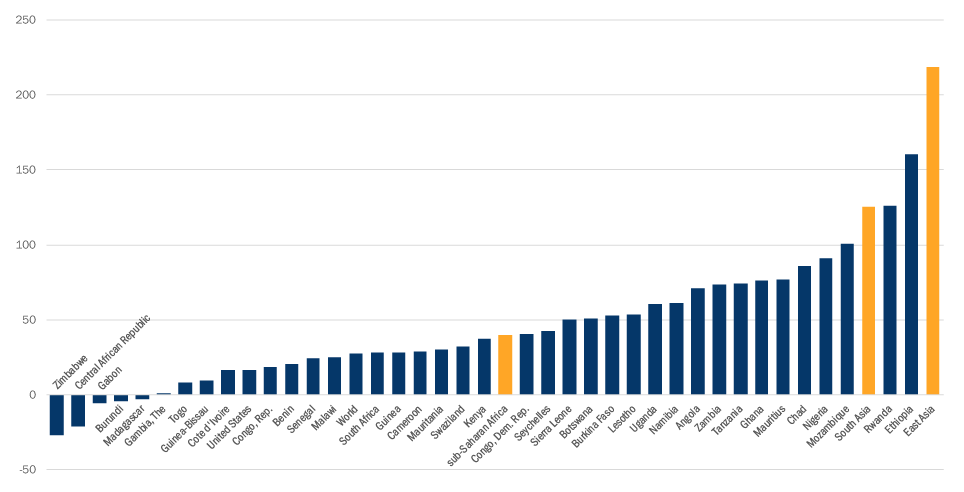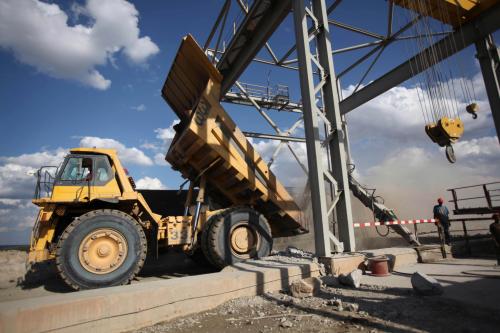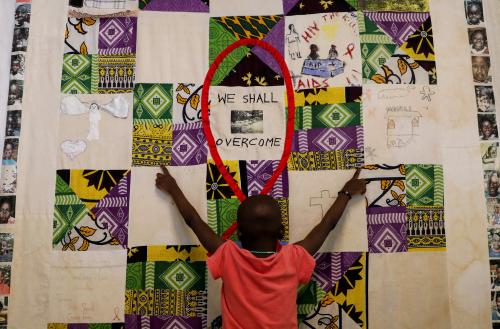This is the second in a series of four blog posts about resource-rich sub-Saharan African countries (specifically, Nigeria, South Africa, Angola, Equatorial Guinea, Gabon, Sudan, Tanzania, Zambia, Botswana, and the Republic of Congo). The first focused on some surprising findings about resource-rich Africa that help demystify how we perceive the resource abundance of the subcontinent.
The top 10 resource-rich countries in sub-Saharan Africa account for 70 percent of the subcontinent’s GDP and physical capital, and 40 percent of the population. Since 2000, growth in the top 10 has been faster than among resource-rich comparators outside Africa. Poverty has reduced among the 10 by 15 percentage points, faster than in the rest of Africa. Nevertheless, just five of sub-Saharan Africa’s top 10 resource-rich countries have grown faster than the sub-Saharan African average. None have grown faster than the average for the East Asia or South Asia regions. And while poverty has declined substantially, more than a third of the population in resource-rich sub-Saharan Africa lives below the $1.90 per day poverty line. In sub-Saharan Africa as a whole, poverty declined to 41.2 percent in 2015, but in absolute terms, the number of poor increased from 2013.
Reinvigorating growth in resource-rich Africa should help propel the region’s economic fortunes and reduce poverty further. In a recent report, my co-authors and I demonstrate that much faster growth is possible in resource-rich Africa based on two pillars:
- More investment in human and physical capital, and
- Strengthened regional integration to boost the size of markets.
Africa has become wealthier but resource-rich Africa grows below potential
Until recently, exploration efforts and discoveries in sub-Saharan Africa were modest. As a result, the value of sub-Saharan Africa’s natural wealth has stagnated for more than 20 years, and its per-capita natural wealth has plunged to just above that of South Asia. Regional aggregates hide large differences between countries. Measured in terms of natural capital per person, Gabon is the 10th richest country in the world. Gabon, Equatorial Guinea, the Republic of Congo, and Angola are the four sub-Saharan African countries in the global ranking of 30 resource-rich countries. The other resource-rich sub-Saharan African countries have much lower endowments in per capita terms; for example, Kenya comes in at 133rd.
In 2000 to 2012, just before the plunge in oil prices, global spending by large mining and oil exploration companies quintupled; in Africa, including North Africa, outlays were about $100 billion in 2012. The companies also discovered giant oil fields offshore in both East and West Africa. Nevertheless, natural resources per square km amount to about $25,000 in sub-Saharan Africa compared with $130,000 in the OECD. There is no reason to believe that sub-Saharan Africa is much less well endowed with subsoil resources and, in fact, geologists suggest the opposite.
Total factor productivity (TFP) received a boost from the introduction of new techniques of exploration and development of resources in the early 2000s. Subsequently, productivity growth moderates and since 2000, TFP contributed just a tenth to growth in resource-rich sub-Saharan Africa. Much faster TFP growth is needed for strong and sustainable economic expansion.
Here lie great opportunities: To improve government institutions and policies, reduce the political and contract risks for exploration companies, and lower the lead time between discovery and production. These goals are complementary to policies and institutions that are necessary to exploit natural resource abundance for economic development. Improving the quality of government and market institutions will reduce discovery and production lead times. Natural wealth per capita could be as much as 25 percent higher if the quality of sub-Saharan Africa’s institutions were to match that of OECD countries. This study suggests that in 1950-89, OECD countries accounted for 37 to 50 percent of total worldwide natural resource discoveries and Africa for less than 9 percent. In the last decade, the share of sub-Saharan Africa nearly doubled to 17 percent.
Sub-Saharan Africa is strongly dependent on its natural capital even though in aggregate, in per capita terms, or per unit of area, the subcontinent is one of the least resource-rich regions in the world. Natural resources dominate the structure of wealth in Africa: The share of natural capital in the continent’s aggregate wealth is the second highest in the world after the countries that form the hydrocarbon-rich Gulf Cooperation Council (GCC). Even resource-poor sub-Saharan Africa, with its relatively low level of natural capital per capita, has a share of natural capital in total wealth that is higher than resource-rich middle-income countries outside Africa. While paradoxical at first glance, it is the consequence of the fact that the contributions of human and physical capital to total wealth are modest both in resource-rich and resource-poor Africa.
The Brookings Institution is committed to quality, independence, and impact.
We are supported by a diverse array of funders. In line with our values and policies, each Brookings publication represents the sole views of its author(s).







Commentary
Resource-rich Africa can boost growth to reduce poverty
September 25, 2018